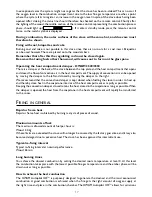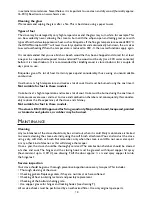
10
display before you hold down the button for a while, you will instead prepare the wood-burning stove
for lighting (the matchbox will appear in the display) and no self-test can be carried out.
Press the remote control button for approx. 5 seconds in order to enter the menu. Press the button
until the cursor reaches “Self-test”. Wait a few seconds till the remote control enters the “Self-test”
menu. Press the button till the cursor reaches “Engage”. A few seconds later the self-test begins.
By going through a self-test you ensure that all basic operations function correctly.
A self-test consists of four test types:
• A software test
• A test of the temperature sensor and calibration
• A test of the lambda sensor and calibration
• A test of the three motor valves and calibration
The remote control will respond with the text ”Pass” if everything is OK or ”Failed” if there is a
problem. The remote control will also respond with the text "Failed" if you, prior to self-test with the
remote control, have prepared the wood-burning stove for lighting up a fire (made the match box
appear on the display). If the electric power is cut and switched on again, the programme will return
to standby and the self-test can be carried out. If the remote control responds with the text "Not
completed", the self-test could not be carried out, either because the wood-burning stove has not
cooled off or because it is not in standby mode.
5. The remote control must be placed in the same room as the wood-burning stove and in a location
where it is neither exposed to direct heat radiation from the stove nor to direct sunlight. The reason
is that the remote control functions as a thermometer. The room temperature is transmitted wirelessly
to the stove’s electronic control to support the intelligent regulation of the combustion. The remote
control stand can be mounted on the wall.
Chimney
The chimney is the “engine” of the stove and it is crucial for the functioning of the woodburning stove.
The chimney draft provides a partial vacuum in the stove. The partial vacuum removes the smoke from
the stove, sucks air through the damper to the so-called pane flush mechanism, which keeps the window
pane soot free, and sucks air into the combustion via the HWAM Autopilot IHS
TM
.
The chimney draft is created by the differences in temperature inside and outside the chimney. A brick
chimney takes longer to warm up than a steel chimney. On days where the weather and wind conditions
create insufficient draught inside the chimney, it is even more important to warm up the chimney as quickly
as possible. The trick is to quickly get some flames going. Split the wood into extra fine pieces, use an extra
firelighter, etc.
If the stove has not been used for a longer period, it is important to check that the chimney pipe is not blocked.
It is possible to connect several devices to the same chimney. However, it is important to first check the
applicable rules.
Even a good chimney can function badly if it is not used correctly. Similarly, a bad chimney may function
well if used correctly.
Chimney sweeping
To prevent the risk of chimney fires, the chimney must be cleaned every year. The flue duct and the smoke
chamber above the baffle plate must be cleaned together with the chimney. If the chimney is too tall to
be cleaned from above, it must be equipped with a soot door.
Summary of Contents for Autopilot IHS 3420
Page 1: ...05 12 2014 97 9662 www hwam com 578 006 Users manual Instruzoni per l uso IT GB 3520 3530 3420...
Page 2: ...2...
Page 4: ...4 B C A 9 11 10 17 1 6 5 8 2a 3 15 4 16 4 3 14 12 13 2b 11 12 14 14 15 3 1 1 4 45 4 3 2 1...
Page 5: ...5 6 2 1 3 4 5 E F...
Page 21: ...21...
Page 37: ...37...
Page 38: ...38...
Page 39: ......
Page 40: ...www hwam com...











































